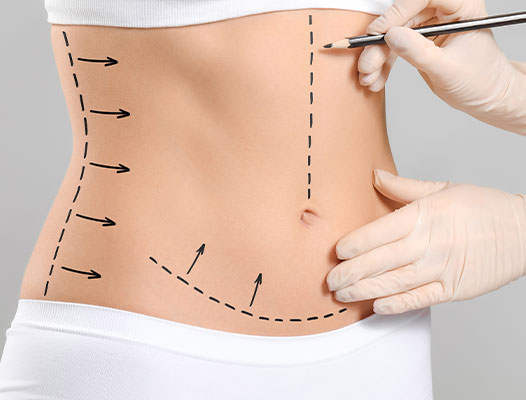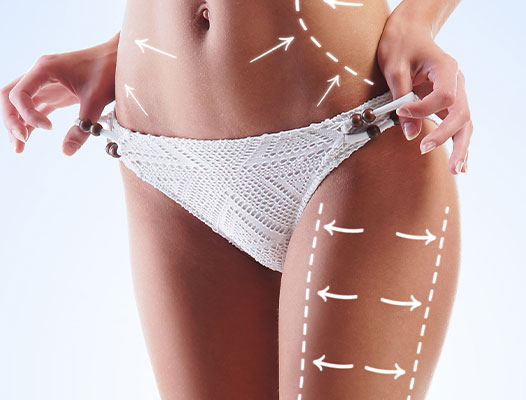Body contouring procedures are designed to reshape and remove excess skin from areas of the body, which have been affected by significant changes in a patient’s weight. The majority of people who seek these procedures have been through bariatric surgery, although many will have lost weight naturally through diet or exercise programs.
While weight loss has major health benefits and reduces other problems such as diabetes or high blood pressure, it can also create unpleasant body shapes because the body is now smaller than its skin. While some skin shrinkage will occur, you may want to consider a body contouring surgery to reduce excess fat and skin. This can also help you further improve your self-image as a major step in your transformation.
Obese individuals who intend to lose weight should postpone all forms of body-contouring surgery until they have reached a stable weight and maintained for one year.
It is important to realize that surgical body reshaping is not an easy, quick-fix intervention – numerous operations may be required to improve body shape, with a three-month interval between each procedure. There are also a number of prerequisites in terms of patient health and fitness. Patients must be able to demonstrate that they are in good general health, and that their weight has been stable for at least one year.
Both functionally and aesthetically, body reshaping can bring about huge improvements but patients must be realistic in their expectations and be prepared to accept that significant scarring will result.
The areas of the body most commonly affected by excess skin after weight loss are:
- Abdomen, flanks and buttocks
- Breasts and back
- Inner thighs
- Arms
Abdomen
Excess abdominal tissue can be removed by a procedure known as an abdominoplasty. If the excess tissue also affects the buttocks and outer thighs, another procedure known as a lower body lift may be required.
Before a body lift operation, the surgeon will make markings on a patient’s trunk to guide them as to how much tissue to remove. During the operation, overhanging abdominal skin and folds from the lower back are excised. As the excision wounds are closed, the buttocks and thighs are lifted by upward traction on the remaining tissue. In some cases, it is possible to use the excess tissue to boost and augment the buttocks. The stomach muscles can also be tightened at the same time.
This is an extensive procedure that typically takes up to six hours to complete. Several surgical drains are left in the wounds to avoid any internal collection of fluid. A postoperative compression or support garment may be advised following the operation, and patients usually need to stay in hospital for several days.
Breasts
Loose breast tissue can be improved by lifting and reshaping the existing fatty tissue and trimming any excess skin. The procedure, known as a mastopexy, usually results in an inverted T-shaped scar; this scar is positioned around the areola and under the nipple within the lower breast fold. Patients having their breast tissue lifted and reshaped may need to have surgical drains inserted and will need to stay in hospital for one-to-two days.
Arms
For loose skin and fatty tissue affecting the upper arms, a procedure known as an arm lift, or brachioplasty, can be performed. Brachioplasty is not a surgical treatment for being overweight. Exercise may strengthen and improve the underlying muscle tone of the upper arm, but it cannot address excess skin that has lost elasticity or underlying weakened tissues and localized fat deposits.
During the operation, the surgeon removes the excess skin and fat by a long incision extending from the elbow to the armpit. The skin edges are then stitched together, and attempts are made to hide the scar by following the line of an imaginary shirt seam. This procedure may be combined with liposuction or breast surgery.
Thighs
A medial thigh lift reshapes sagging or loose inner thighs by reducing excess skin and, in some cases, fat, resulting in smoother skin and better-proportioned contours of the thighs and lower body. For individuals who still have a moderate amount of fat deposits, a combination of liposuction and thigh lift procedure may be recommended. Exercise may strengthen and improve the underlying muscle tone of the thighs, but it cannot address excess skin that has lost elasticity or underlying weakened tissues and localized fat deposits.
During the procedure the layers of excess skin and fat are removed. The skin edges are then stitched together, with a scar placed in the groin, extending around the back of the thigh. In some cases, the incision may be required to extend from the knee to groin on the inside of the thigh. After the excess skin and localized fat deposits are excised, your incisions will be closed. In some cases, a surgical drain may be required.
Body contouring procedures can help to reduce uncomfortable and unsightly loose skin and to reshape the body for a smoother, firmer appearance. Although significant scarring results, it is well accepted by patients if positioned correctly. The location of the scar can be chosen before the surgery in order to adapt as well as possible to the type of clothing worn by the patient.
Patients are often delighted with the effectiveness of body contouring procedures, as they are able to improve the appearance of areas of the body, which are difficult or impossible to change with diet and exercise alone. Patients also find that their options when choosing clothing are greatly improved.
- Every surgical procedure carries some risk. Potential complications may include reactions to anaesthesia, blood accumulation that may need to be drained surgically, and infection.
- All body reshaping surgery results in significant scarring, although the nature of the scars will depend on the technique that has been used. There are individual factors with wound healing and scarring that may be unpredictable. Scars tend to be quite red and raised in the first six weeks, changing over the next six months or so and then fading to white. Most patients will form good quality scars over time, but occasionally and unpredictably some patients will get red lumpy scars that do not improve. These may require scar revisionary procedures.
- Body reshaping procedures are major operations and patients must be prepared for the process and recovery period involved. Most patients are delighted with the physical and cosmetic improvements that the surgery brings; however, it is impossible to guarantee that every patient will be completely satisfied with the result. There will be minor asymmetries in respect of the scars and possibly residual bulges. A perfect shape cannot be restored after massive weight loss.
- Occasionally patients will bleed immediately after the operation and need to go back to the operating room for this to be dealt with.
- Wound healing problems can occur. Most wound problems are minor and can be managed with simple dressings; however more major wound problems can arise such as infections, skin loss, wound separation and delayed healing. Wound problems, if they occur, can delay your recovery and result in worse scarring.
- In some patients fluid will collect in the in the region of the operation. If this occurs, the fluid needs to be removed using a needle.
- All patients can expect alteration in the feeling of the skin in the area of the operation and this is usually permanent.
- These operations carry a risk of blood clots in the legs and possibly the lungs. Various precautions are taken to limit this risk but if a blood clot occurs, treatment with blood thinning medication will be needed for several months.
Mommy Makeover

Over the past decade, plastic surgeons have witnessed a sharp rise in the number of mothers electing to have breast and body sculpting surgeries to correct the aesthetic problems resulting from pregnancy and childbirth, and they have named this phenomenon a Mommy Makeover.
Tummy tuck

Abdominoplasty, also known as ‘tummy tuck’, is a major surgical body contouring procedure performed on both men and, more commonly, women. The procedure is designed to improve the appearance of the abdominal area, which may have been affected by pregnancy or significant weight loss.
Liposuction

Liposuction, also called Lipoplasty and suction-assisted lipectomy, can help sculpt the body by removing unwanted deposits of excess fat from specific areas of the body including the face and neck. The procedure can slim hips and thighs, flatten the abdomen, shape the calves and ankles, or eliminate a double chin.
"Cherish your body, forever and beyond."
Contact us now to schedule an appointment.
